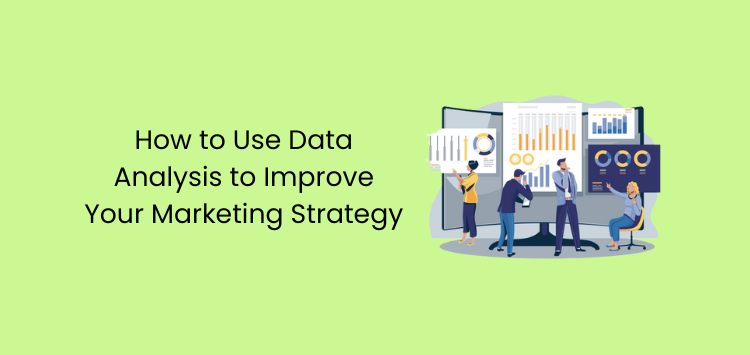Companies today must use data to make good choices and come up with good marketing strategies in today’s data-driven world. By looking at marketing data, companies can learn a lot about how their customers act, what they like, and what they need. This is also true for eCommerce websites that particularly use WordPress plugins and apps to boost their offerings. Whether you’re trying to increase website traffic, boost conversion rates, or improve customer retention, data analysis can help you achieve your business goals.
Data analysis can help you reach your goals, whether you want to get more people to visit your website, increase the number of people who buy from you, or keep customers coming back.
In this article, we’ll talk about how e-commerce websites, agencies and companies can use data analysis to improve their marketing strategies. First, we’ll talk about why data analysis is important in marketing and how it can help you make better decisions. Then, we’ll talk about the most important things businesses should think about when studying marketing data, such as where to find data, what kinds of data to use, and how to analyze data well. Lastly, we’ll show you how to use data analysis in the real world to improve your marketing plan and reach your business goals.
What is Marketing Data?
Marketing data refers to information and statistics that are collected and analyzed to gain insights into consumer behaviour and preferences, as well as to evaluate the effectiveness of marketing strategies.
This data is typically collected from various sources, including websites, chat apps, social media platforms, customer surveys, and sales records.
Marketing data differs from other types of data in that it is specifically focused on understanding and improving marketing efforts. Unlike financial data or operational data, which provide information about a company’s financial health or internal processes, marketing data is focused on understanding the customer journey and optimizing marketing tactics to improve conversions and sales.
For e-commerce websites, collecting marketing data is crucial for understanding customer behaviour and preferences, as well as for evaluating the effectiveness of marketing strategies. By analyzing marketing data, companies can identify areas for improvement in their sales funnel, optimize their website for conversions, and target their marketing efforts more effectively.
Without marketing data, companies would be flying blind and potentially wasting resources on ineffective marketing strategies.
Where Can You Find Marketing Data?
Marketing data can come from a wide range of sources, both online and offline. Here are some common sources of marketing data:
- Website analytics tools: Tools like Google Analytics can provide a wealth of information about your website visitors, such as where they’re coming from, which pages they’re visiting, and how long they’re staying on your site.
- Live Chat Apps: Live Chat apps are great for learning about the preferences of your customers, getting information about your products and services, and learning what makes a customer excited about your company.
- Social media platforms: Social media platforms like Facebook and Twitter provide access to demographic data about your followers, as well as engagement metrics like likes, shares, and comments.
- Customer relationship management (CRM) systems: If you have a CRM system in place, you can use it to track customer interactions and behaviour, including purchases, support inquiries, and other interactions.
- Third-party data providers: There are many companies that specialize in providing marketing data. These providers can offer access to demographic data, market research, and other types of information.
It’s important to note that data integration and collecting information from multiple sources can provide a more complete picture of your audience and their behavior. However, it’s also crucial to ensure that the data you’re collecting is of high quality and accuracy.
Dirty or inaccurate data resulting from poor data integration can lead to incorrect insights and ineffective marketing strategies
When collecting data, it’s important to have a clear understanding of what you’re trying to achieve and which metrics are most relevant to your goals. By being selective about the data you collect and analyzing it carefully, you can gain valuable insights that can inform your marketing strategy and help you drive better results.
What are the Different Types of Data Used By Businesses?
Businesses use various types of data to build effective marketing strategies. Here are some of the most common types of data that businesses use:
- Demographic data – This type of data includes information about the characteristics of a target audience, such as age, gender, income, education, and location. Demographic data can help businesses better understand their audience and tailor their marketing messages accordingly.
- Behavioural data – Behavioral data includes information about how consumers interact with a company’s products or services. This type of data can include website interactions, social media engagement, your average engagement rate email click-through rates, and more. Behavioral data can help businesses identify patterns in consumer behaviour and adjust their marketing strategies accordingly.
- Transactional data – This type of data includes information about customer purchases and transactions, such as order history, purchase frequency, and average order value. Transactional data can help businesses understand customer preferences, identify cross-selling and upselling opportunities, and optimize pricing and promotions.
Each type of data plays an important role in building an effective marketing strategy. Businesses can understand who their target audience is and what their preferences and needs are.
Overall, using a combination of these different types of data can provide businesses with a comprehensive understanding of their audience and help them build effective marketing strategies that drive results. After compiling relevant data, the next step is to analyze such data and learn how to use it to improve conversions, sales and leads for your business.
How Can You Analyze Marketing Data?
Among the most important steps in analyzing marketing data are data cleaning, data display, and modelling.
Data cleaning: Before you can start analyzing your marketing data, you need to make sure it’s accurate and complete. This involves identifying and correcting errors, removing duplicate entries, and filling in missing values.
Visualization: Once your data is cleaned and organized, you can start visualizing it to identify patterns and trends. This can be done using graphs, charts, and other visual aids. Visualization can help you identify correlations between different data points and uncover insights that may not be immediately apparent from the raw data.
Modelling: After you’ve visualized your data, you can start building models to test hypotheses and predict outcomes. This involves using statistical techniques to identify relationships between different variables and make predictions based on those relationships.
For example, you might build a model to predict which customers are most likely to make a purchase based on their browsing history and demographic information.
There are different modelling techniques that can be used including predictive modelling, segmentation modelling, attribution modelling, and optimization modelling.
For example, you might use optimization modelling to identify the most effective email marketing strategy based on factors like subject lines, send frequency, and content. You may also use predictive modeling to forecast which customers are most likely to make a purchase based on their browsing and purchase history.
It’s important to note that statistical significance and hypothesis testing are crucial components of data analysis in marketing. These techniques help ensure that the insights you uncover are meaningful and reliable.
Statistical significance refers to the likelihood that an observed effect is not due to chance, while hypothesis testing involves testing a specific hypothesis using statistical analysis. By using these techniques, you can be confident that the insights you uncover from your marketing data are accurate and actionable.
How to Use Data Analysis to Improve Your Marketing Strategy
Optimize your sales funnel
A sales funnel is the journey that a customer goes through from initial awareness to making a purchase. By analyzing data on each stage of the funnel, businesses can identify areas where customers are dropping off and make adjustments to improve conversion rates. For example, businesses can use data analysis to optimize their landing pages, improve their email marketing campaigns, and refine their lead generation strategies.
Improve specific marketing strategies
Data analysis can also help businesses improve specific marketing strategies, such as email marketing and content marketing. For example, businesses can use data analysis to track the performance of their email campaigns, including open rates, click-through rates, and conversion rates. This data can be used to identify the most effective types of email content, as well as the best times and days to send emails. Similarly, data analysis can help businesses track the performance of their content marketing efforts, including which types of content are generating the most traffic and engagement.
Image source: Blogin
Leverage the role of a knowledge manager
A knowledge manager is someone who is responsible for collecting, organizing, and analyzing knowledge to improve business performance. In the context of marketing, a knowledge manager can help businesses leverage marketing data for continuous improvement. By analyzing data on an ongoing basis, a knowledge manager can identify trends and patterns that can inform strategic decision-making. For example, a knowledge manager that interfaces with the sales and marketing team might use data analysis to identify new market opportunities, develop more effective marketing campaigns, and improve customer retention rates.
Identify customer segments
Data analysis can help businesses identify different customer segments based on factors such as demographics, behaviour, and preferences. An understanding of the unique needs and preferences of each segment can help businesses to tailor their marketing efforts to better resonate with their target audience. For example, businesses can use data analysis to identify which products or services are most popular among different customer segments and develop targeted marketing campaigns to reach each segment.
Monitor competitor activity
Data analysis can also help businesses monitor their competitors’ marketing activity and identify opportunities to differentiate themselves in the market. By tracking competitor data such as pricing, promotions, and messaging, businesses can adjust their own marketing strategies to stay ahead of the competition. For example, businesses can use data analysis to identify gaps in the market where their competitors are not meeting customer needs and develop marketing campaigns to address those gaps.
Conclusion
We have also seen how data analysis can inform specific marketing strategies, such as email marketing and content marketing, and how a knowledge manager can play a critical role in leveraging marketing data for continuous improvement.
It is more important than ever to use data analysis to gain a competitive edge, make informed decisions, achieve greater ROI, and ultimately drive more sales.
As a business owner or website proprietor, we encourage you to use data analysis in your own marketing efforts. Start by identifying your key metrics, collecting data from various sources, and using data analysis tools to identify patterns, trends, and opportunities.









